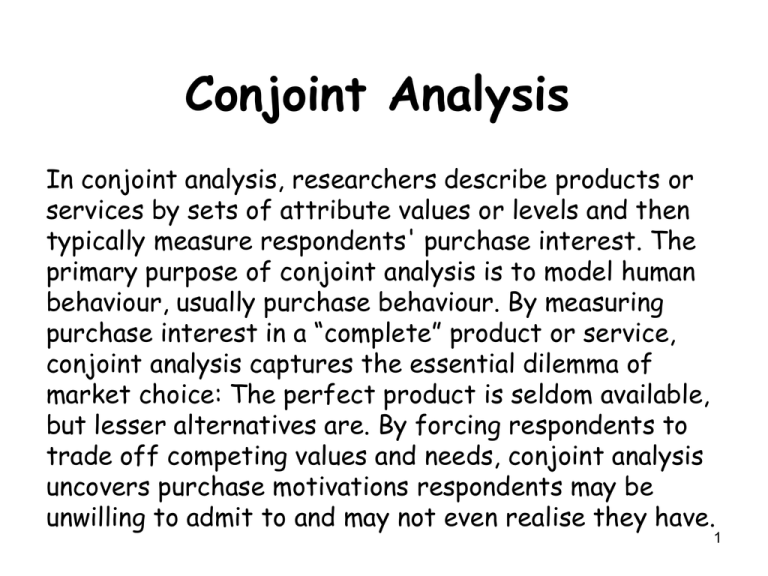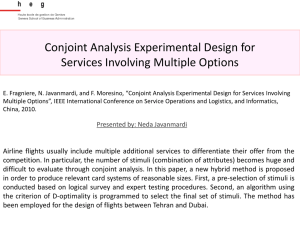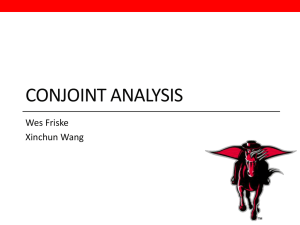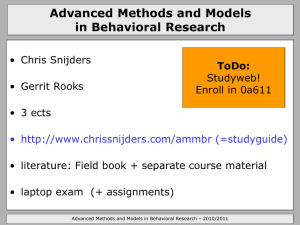Conjoint Analysis
advertisement

Conjoint Analysis In conjoint analysis, researchers describe products or services by sets of attribute values or levels and then typically measure respondents' purchase interest. The primary purpose of conjoint analysis is to model human behaviour, usually purchase behaviour. By measuring purchase interest in a “complete” product or service, conjoint analysis captures the essential dilemma of market choice: The perfect product is seldom available, but lesser alternatives are. By forcing respondents to trade off competing values and needs, conjoint analysis uncovers purchase motivations respondents may be unwilling to admit to and may not even realise they have. 1 Conjoint Analysis - Caution A potential concern for any approach that accommodates a large number of attributes is attribute additivity. Seldom mentioned in the literature, attribute additivity is the phenomenon where a large number of less important attributes may overwhelm one or two extremely important ones. For example, a feature-rich product may have more total utility than a low-priced one simply because all the small utility weights of the various product features, when summed, exceed the utility weight of the price attribute. McCullough D., A User's Guide To Conjoint Analysis, Marketing Research, 2002, 14(2), 18-22. 2 Conjoint Analysis Within medicine, understanding how patients and other stakeholders value various aspects of an intervention in health care is vital to both the design and evaluation of programs. Incorporating these values in decision making may ultimately result in clinical, licensing, reimbursement, and policy decisions that better reflect the preferences of stakeholders, especially patients. Aligning health care policy with patient preferences could improve the effectiveness of health care interventions by improving adoption of, satisfaction with, and adherence to clinical treatments or public health programs. 3 Conjoint Analysis Methods using ranking, rating, or choice designs (either individually or in combination) to quantify preferences for various attributes of an intervention (often referred to as conjoint analysis, discrete-choice experiments, or stated-choice methods). Conjoint-analysis methods are particularly useful for quantifying preferences for nonmarket goods and services or where market choices are severely constrained by regulatory and institutional factors, such as in health care. 4 Conjoint Analysis The checklist should be used to understand the steps involved in producing good conjoint-analysis research in health care. Bridges, J.F.P., Hauber, A.B., Marshall, D., Lloyd, A., Prosser, L.A., Regier, D.A., Johnson, F.R. and Mauskopf, J., Conjoint Analysis Applications in Health-a Checklist: A Report of the ISPOR Good Research Practices for Conjoint Analysis Task Force, Value In Health, Volume: 14 Issue: 4, Pages: 403-413, 2011. 5 Conjoint Analysis See also Constructing Experimental Designs for Discrete-Choice Experiments: Report of the ISPOR Conjoint Analysis Experimental Design Good Research Practices Task Force Johnson, F.R., Lancsar, E., Marshall, D., Kilambi, V., Muhlbacher, A., Regier, D.A., Bresnahan, B.W., Kanninen, B. and Bridges, J.F.P Value In Health, 16(1), 3-13, 2013. But beware of Discrete Choice Experiments Are Not Conjoint Analysis Louviere J.J., Flynn T.N. and Carson R.T. 6 Journal of Choice Modelling, 3(3), 57-72, 2010. Conjoint Analysis 1. Was a well-defined research question stated and is conjoint analysis an appropriate method for answering it? 1.1 Were a well-defined research question and a testable hypothesis articulated? 1.2 Was the study perspective described, and was the study placed in a particular decisionmaking or policy context? 1.3 What is the rationale for using conjoint analysis to answer the research question? 7 Conjoint Analysis 2. Was the choice of attributes and levels supported by evidence? 2.1 Was attribute identification supported by evidence (literature reviews, focus groups, or other scientific methods)? 2.2 Was attribute selection justified and consistent with theory? 2.3 Was level selection for each attribute justified by the evidence and consistent with the study perspective and hypothesis? 8 Conjoint Analysis 3. Was the construction of tasks appropriate? 3.1 Was the number of attributes in each conjoint task justified (that is, full or partial profile)? 3.2 Was the number of profiles in each conjoint task justified? 3.3 Was (should) an opt-out or a status-quo alternative (be) included? 9 Conjoint Analysis 4. Was the choice of experimental design justified and evaluated? 4.1 Was the choice of experimental design justified? Were alternative experimental designs considered? 4.2 Were the properties of the experimental design evaluated? 4.3 Was the number of conjoint tasks included in the datacollection instrument appropriate? 10 Conjoint Analysis 5. Were preferences elicited appropriately, given the research question? 5.1 Was there sufficient motivation and explanation of conjoint tasks? 5.2 Was an appropriate elicitation format (that is, rating, ranking, or choice) used? Did (should) the elicitation format allow for indifference? 5.3 In addition to preference elicitation, did the conjoint tasks include other qualifying questions (for example, strength of preference, confidence in response, and other methods)? 11 Conjoint Analysis 6. Was the data collection instrument designed appropriately? 6.1 Was appropriate respondent information collected (such as socio-demographic, attitudinal, health history or status, and treatment experience)? 6.2 Were the attributes and levels defined, and was any contextual information provided? 6.3 Was the level of burden of the data-collection instrument appropriate? Were respondents encouraged and motivated? 12 Conjoint Analysis 7. Was the data-collection plan appropriate? 7.1 Was the sampling strategy justified (for example, sample size, stratification, and recruitment)? 7.2 Was the mode of administration justified and appropriate (for example, faceto-face, pen-and-paper, webbased)? 7.3 Were ethical considerations addressed (for example, recruitment, information and/or consent, compensation)? 13 Conjoint Analysis 8. Were statistical analyses and model estimations appropriate? 8.1 Were respondent characteristics examined and tested? 8.2 Was the quality of the responses examined (for example, rationality, validity, reliability)? 8.3 Was model estimation conducted appropriately? Were issues of clustering and subgroups handled appropriately? 14 Conjoint Analysis 9. Were the results and conclusions valid? 9.1 Did study results reflect testable hypotheses and account for statistical uncertainty? 9.2 Were study conclusions supported by the evidence and compared with existing findings in the literature? 9.3 Were study limitations and generalizability adequately discussed? 15 Conjoint Analysis 10. Was the study presentation clear, concise, and complete? 10.1 Was study importance and research context adequately motivated? 10.2 Were the study datacollection instrument and methods described? 10.3 Were the study implications clearly stated and understandable to a wide audience? 16 Conjoint Analysis - Example This presentation is loosely based on notes from IBM/SPSS main and statistics examples. In a popular example of conjoint analysis (Green and Wind, 1973), a company interested in marketing a new carpet cleaner wants to examine the influence of five factors on consumer preference - package design, brand name, price, a Good Housekeeping seal, and a money-back guarantee. 17 Conjoint Analysis - Example There are three factor levels for package design, each one differing in the location of the applicator brush; three brand names (K2R, Glory, and Bissell); three price levels; and two levels (either no or yes) for each of the last two factors. The following table displays the variables used in the carpet-cleaner study, with their variable labels and values. Variable name Variable label Value label package package design A*, B*, C* brand brand name K2R, Glory, Bissell price price $1.19, $1.39, $1.59 seal Good Housekeeping seal no, yes money money-back guarantee no, yes 18 Conjoint Analysis There could be other factors and factor levels that characterize carpet cleaners, but these are the only ones of interest to management. This is an important point in conjoint analysis. You want to choose only those factors (independent variables) that you think most influence the subject's preference (the dependent variable). Using conjoint analysis, you will develop a model for customer preference based on these five factors. Green, P. E., and Y. Wind. 1973. Multiattribute decisions in marketing: A measurement approach. Hinsdale, Ill.: Dryden Press. 19 Conjoint Analysis The first step in a conjoint analysis is to create the combinations of factor levels that are presented as product profiles to the subjects. Since even a small number of factors and a few levels for each factor will lead to an unmanageable number of potential product profiles, you need to generate a representative subset known as an orthogonal array. 20 Conjoint Analysis The “Generate Orthogonal Design” procedure creates an orthogonal array - also referred to as an orthogonal design - and stores the information in a data file. Unlike most procedures, an active dataset is not required before running the Generate Orthogonal Design procedure. If you do not have an active dataset, you have the option of creating one, generating variable names, variable labels, and value labels from the options that you select in the dialog boxes. If you already have an active dataset, you can either replace it or save the orthogonal design as a separate data file. 21 Conjoint Analysis To create an orthogonal design: ► From the menus choose: Data > Orthogonal Design > Generate 22 Conjoint Analysis ► Enter package in the Factor Name text box, and enter package design in the Factor Label text box. ► Click Add 23 Conjoint Analysis This creates an item labelled package 'package design' (?). Select this item. ► Click Define Values. 24 Conjoint Analysis ► Enter the values 1, 2, and 3 to represent the package designs A*, B*, and C*. Enter the labels A*, B*, and C* as well. ► Click Continue. 25 Conjoint Analysis You'll now want to repeat this process for the remaining factors, brand, price, seal, and money. 26 Conjoint Analysis Use the values and labels from the following table, which includes the values you've already entered for package. Factor name Factor label Values Labels package package design 1, 2, 3 A*, B*, C* brand brand name 1, 2, 3 K2R, Glory, Bissell price price 1.19, 1.39, 1.59 $1.19, $1.39, $1.59 seal Good Housekeeping seal 1, 2 no, yes money money-back guarantee 1, 2 no, yes 27 Conjoint Analysis Once you have completed the factor specifications: ► In the Data File group, leave the default of Create a new dataset 28 Conjoint Analysis Enter a dataset name. The generated design will be saved to a new dataset, in the current session, with the specified name. ► Select Reset random number seed to and enter the value 2000000. 29 Conjoint Analysis Generating an orthogonal design requires a set of random numbers. If you want to duplicate a design - in this case, the design used for the present case study - you need to set the seed value before you generate the design and reset it to the same value each subsequent time you generate the design. The design used for this case study was generated with a seed value of 2000000. This value is essential to ensure repeat analysis will reproduce identical results. 30 Conjoint Analysis ► In the Data File group, change the default of Create a new data file Enter a data file name (with appropriate directory structure for your machine). The generated design will be saved to a new data file. 31 Conjoint Analysis ► Click Options 32 Conjoint Analysis ► In the Minimum number of cases to generate text box, type 18. 33 Conjoint Analysis By default, the minimum number of cases necessary for an orthogonal array is generated. The procedure determines the number of cases that need to be administered to allow estimation of the utilities. You can also specify a minimum number of cases to generate, as you've done here. You might want to do this because the default number of minimum cases is too small to be useful or because you have experimental design considerations 34 that require a certain minimum number of cases. Conjoint Analysis ► Select Number of holdout cases and type 4. Holdout cases are judged by the subjects but are not used by the conjoint analysis to estimate utilities. They are used as a check on the validity of the estimated utilities. The holdout cases are generated from another random plan, not the experimental orthogonal plan. 35 Conjoint Analysis ► Click Continue in the Generate Orthogonal Design Options dialog box. 36 Conjoint Analysis ► Click OK in the Generate Orthogonal Design dialog box. 37 Conjoint Analysis The syntax is *Generate Orthogonal Design. SET SEED 2000000. ORTHOPLAN /FACTORS=package 'package design' (1 'A*' 2 'B*' 3 'C*') brand 'brand name' (1 'K2R' 2 'Glory' 3 'Bissell') price 'price' (1.19 '$1.19' 1.39 '$1.39' 1.59 '$1.59') seal 'Good Housekeeping seal' (1 'no' 2 'yes') money 'money-back guarantee' (1 'no' 2 'yes') /OUTFILE='15a.sav' /MINIMUM 18 /HOLDOUT 4 /MIXHOLD NO. 38 Conjoint Analysis The orthogonal design is displayed in the Data Editor and is best viewed by displaying value labels rather than the actual data values. This is accomplished by choosing Value Labels from the View menu. To retrieve your saved plan. 39 Conjoint Analysis 40 Conjoint Analysis The orthogonal design is a required input to the analysis of the data. Therefore, you will want to save your design to a data file. For convenience, the current design has been saved in 15a.sav (orthogonal designs are also referred to as plans). Once you have created an orthogonal design, you'll want to use it to create the product profiles to be rated by the subjects. You can obtain a listing of the profiles in a single table or display each profile in a separate table. 41 Conjoint Analysis To display an orthogonal design: ► From the menus choose: Data > Orthogonal Design > Display 42 Conjoint Analysis ► Select package, brand, price, seal, and money for the factors. 43 Conjoint Analysis The variables in the data file are the factors used to specify the design. Each case represents one product profile in the design. Notice that two additional variables, CARD_ and STATUS_, appear in the data file. CARD_ assigns a sequential number to each profile that is used to identify the profile. STATUS_ indicates whether a profile is part of the experimental design (the first 18 cases), a holdout case (the last 4 cases), or a simulation case (to be discussed in a later topic in this case study). The information contained in the variables STATUS_ and CARD_ is automatically included in the output, so they 44 don't need to be selected. Conjoint Analysis ► Select Listing for experimenter in the Format group. This results in displaying the entire orthogonal design in a single table. ► Click OK. 45 Conjoint Analysis Card List Good House Card package brand keeping ID design name price seal 1 1 A* Glory $1.39 yes 2 2 B* K2R $1.19 no 3 3 B* Glory $1.39 no 4 4 C* Glory $1.59 no 5 5 C* Bissell $1.39 no 6 6 A* Bissell $1.39 no 7 7 B* Bissell $1.59 yes 8 8 A* K2R $1.59 no 9 9 C* K2R $1.39 no 10 10 C* Glory $1.19 no 11 11 C* K2R $1.59 yes 12 12 B* Glory $1.59 no 13 13 C* Bissell $1.19 yes 14 14 A* Glory $1.19 yes 15 15 B* K2R $1.39 yes 16 16 A* K2R $1.19 no 17 17 A* Bissell $1.59 no 18 18 B* Bissell $1.19 no 19a 19 A* Bissell $1.59 yes a 20 20 C* K2R $1.19 yes 21a 21 A* Glory $1.59 no 22a 22 A* Bissell $1.19 no a. Holdout money-back guarantee no no yes no no no no yes no yes no no yes no yes no yes no no no no no The output resembles the look of the orthogonal design as shown in the Data Editor—one row for each profile, with the factors as columns. Notice, however, that the column headers are the variable labels rather than the variable names that you see in the Data Editor. 46 Conjoint Analysis Card List Good House Card package brand keeping ID design name price seal 1 1 A* Glory $1.39 yes 2 2 B* K2R $1.19 no 3 3 B* Glory $1.39 no 4 4 C* Glory $1.59 no 5 5 C* Bissell $1.39 no 6 6 A* Bissell $1.39 no 7 7 B* Bissell $1.59 yes 8 8 A* K2R $1.59 no 9 9 C* K2R $1.39 no 10 10 C* Glory $1.19 no 11 11 C* K2R $1.59 yes 12 12 B* Glory $1.59 no 13 13 C* Bissell $1.19 yes 14 14 A* Glory $1.19 yes 15 15 B* K2R $1.39 yes 16 16 A* K2R $1.19 no 17 17 A* Bissell $1.59 no 18 18 B* Bissell $1.19 no 19a 19 A* Bissell $1.59 yes a 20 20 C* K2R $1.19 yes 21a 21 A* Glory $1.59 no 22a 22 A* Bissell $1.19 no a. Holdout money-back guarantee no no yes no no no no yes no yes no no yes no yes no yes no no no no no Also notice that the holdout cases are identified with a footnote. This is of interest to the experimenter, but you certainly don't want the subjects to know which, if any, cases are holdouts. 47 Conjoint Analysis Card List Good House Card package brand keeping ID design name price seal 1 1 A* Glory $1.39 yes 2 2 B* K2R $1.19 no 3 3 B* Glory $1.39 no 4 4 C* Glory $1.59 no 5 5 C* Bissell $1.39 no 6 6 A* Bissell $1.39 no 7 7 B* Bissell $1.59 yes 8 8 A* K2R $1.59 no 9 9 C* K2R $1.39 no 10 10 C* Glory $1.19 no 11 11 C* K2R $1.59 yes 12 12 B* Glory $1.59 no 13 13 C* Bissell $1.19 yes 14 14 A* Glory $1.19 yes 15 15 B* K2R $1.39 yes 16 16 A* K2R $1.19 no 17 17 A* Bissell $1.59 no 18 18 B* Bissell $1.19 no 19a 19 A* Bissell $1.59 yes a 20 20 C* K2R $1.19 yes 21a 21 A* Glory $1.59 no 22a 22 A* Bissell $1.19 no a. Holdout money-back guarantee no no yes no no no no yes no yes no no yes no yes no yes no no no no no Depending on how you create and deliver your final product profiles, you may want to save this table as an HTML, Word/RTF, Excel, or PowerPoint file. This is easily accomplished by selecting the table in the Viewer, right clicking, and selecting Export. Also, if you're using the exported version to create the final product profiles, be sure to edit out the footnotes for the holdout cases. 48 Conjoint Analysis Perhaps the needs for your survey are better served by generating a separate table for each product profile. This choice lends itself nicely to exporting to PowerPoint, since each table (product profile) is placed on a separate PowerPoint slide. 49 Conjoint Analysis To display each profile in a separate table: ► Click the Dialog Recall button and select Display Design. ► Deselect Listing for experimenter and select Profiles for subjects. ► Click OK. 50 Conjoint Analysis The information for each product profile is displayed in a separate table. In addition, holdout cases are indistinguishable from the rest of the cases, so there is no issue of removing identifiers for holdouts as with the single table layout. Profile Number 1 Card ID Good Housekeeping money-back seal guarantee yes no … package design brand name price 1 A* Glory $1.39 … Profile Number 22 Card ID package design brand name price 22 A* Bissell $1.19 Good Housekeeping money-back seal guarantee no no 51 Conjoint Analysis You've generated an orthogonal design and learned how to display the associated product profiles. You're now ready to learn how to run a conjoint analysis. The preference data collected from the subjects is stored in 15b.sav. ID PREF1 PREF2 PREF3 PREF4 PREF5 PREF6 PREF7 PREF8 PREF9 PREF10 PREF11 PREF12 PREF13 PREF14 PREF15 PREF16 PREF17 PREF18 PREF19 PREF20 PREF21 PREF22 1 1 13 15 1 20 14 7 11 19 3 10 17 8 5 9 6 12 4 21 18 2 22 16 2 2 15 7 18 2 12 3 11 20 16 21 6 22 8 17 19 1 14 4 9 5 10 13 3 3 2 18 14 16 22 13 20 10 15 3 1 6 9 5 7 12 19 8 17 21 11 4 4 4 13 10 20 14 2 18 16 22 15 3 1 9 5 6 8 17 11 7 19 4 12 21 5 5 13 18 2 10 20 15 9 5 3 7 11 4 12 22 14 16 1 6 19 21 17 8 6 6 15 2 3 12 18 7 20 10 11 4 9 5 13 16 14 22 8 6 1 21 19 17 7 7 13 7 15 18 2 3 10 20 14 11 19 17 12 1 9 5 4 6 8 16 21 22 8 8 15 7 13 4 6 16 8 22 5 9 21 18 10 3 2 20 14 11 17 19 1 12 9 9 20 9 10 11 4 5 13 15 2 3 12 18 7 1 21 14 16 22 8 6 17 19 10 10 8 21 19 17 4 11 12 7 1 6 9 5 3 15 14 16 22 20 10 13 2 18 52 Conjoint Analysis The data consist of responses from 10 subjects, each identified by a unique value of the variable ID. Subjects were asked to rank the 22 product profiles from the most to the least preferred. The variables PREF1 through PREF22 contain the IDs of the associated product profiles, that is, the card IDs from 15a.sav. Subject 1, for example, liked profile 13 most of all, so PREF1 has the value 13. ID PREF1 PREF2 PREF3 PREF4 PREF5 PREF6 PREF7 PREF8 PREF9 PREF10 PREF11 PREF12 PREF13 PREF14 PREF15 PREF16 PREF17 PREF18 PREF19 PREF20 PREF21 PREF22 1 1 13 15 1 20 14 7 11 19 3 10 17 8 5 9 6 12 4 21 18 2 22 16 2 2 15 7 18 2 12 3 11 20 16 21 6 22 8 17 19 1 14 4 9 5 10 13 3 3 2 18 14 16 22 13 20 10 15 3 1 6 9 5 7 12 19 8 17 21 11 4 4 4 13 10 20 14 2 18 16 22 15 3 1 9 5 6 8 17 11 7 19 4 12 21 5 5 13 18 2 10 20 15 9 5 3 7 11 4 12 22 14 16 1 6 19 21 17 8 6 6 15 2 3 12 18 7 20 10 11 4 9 5 13 16 14 22 8 6 1 21 19 17 7 7 13 7 15 18 2 3 10 20 14 11 19 17 12 1 9 5 4 6 8 16 21 22 8 8 15 7 13 4 6 16 8 22 5 9 21 18 10 3 2 20 14 11 17 19 1 12 9 9 20 9 10 11 4 5 13 15 2 3 12 18 7 1 21 14 16 22 8 6 17 19 10 10 8 21 19 17 4 11 12 7 1 6 9 5 3 15 14 16 22 20 10 13 2 18 53 Conjoint Analysis Analysis of the data is a task that requires the use of command syntax - A graphical user interface is not yet available for the Conjoint procedure. To obtain a conjoint analysis, you must enter command syntax for a CONJOINT command into a syntax window and then run it. Source 54 Conjoint Analysis Analysis of the data is a task that requires the use of command syntax - specifically, the CONJOINT command. The necessary command syntax has been provided below. CONJOINT PLAN='15a.sav' /DATA='15b.sav' /SEQUENCE=PREF1 TO PREF22 /SUBJECT=ID /FACTORS=PACKAGE BRAND (DISCRETE) PRICE (LINEAR LESS) SEAL (LINEAR MORE) MONEY (LINEAR MORE) /PRINT=SUMMARYONLY. 55 Conjoint Analysis CONJOINT PLAN='15a.sav' /DATA='15b.sav' /SEQUENCE=PREF1 TO PREF22 /SUBJECT=ID /FACTORS=PACKAGE BRAND (DISCRETE) PRICE (LINEAR LESS) SEAL (LINEAR MORE) MONEY (LINEAR MORE) /PRINT=SUMMARYONLY. The PLAN subcommand specifies the file containing the orthogonal design - in this example, 15a.sav. 56 Conjoint Analysis CONJOINT PLAN='15a.sav' /DATA='15b.sav' /SEQUENCE=PREF1 TO PREF22 /SUBJECT=ID /FACTORS=PACKAGE BRAND (DISCRETE) PRICE (LINEAR LESS) SEAL (LINEAR MORE) MONEY (LINEAR MORE) /PRINT=SUMMARYONLY. The DATA subcommand specifies the file containing the preference data - in this example, 15b.sav. If you choose the preference data as the active dataset, you can replace the file specification with an asterisk (*), without the quotation marks. You will have to adjust the file address. 57 Conjoint Analysis CONJOINT PLAN='15a.sav' /DATA='15b.sav' /SEQUENCE=PREF1 TO PREF22 /SUBJECT=ID /FACTORS=PACKAGE BRAND (DISCRETE) PRICE (LINEAR LESS) SEAL (LINEAR MORE) MONEY (LINEAR MORE) /PRINT=SUMMARYONLY. The SEQUENCE subcommand specifies that each data point in the preference data is a profile number, starting with the most-preferred profile and ending with the leastpreferred profile. 58 Conjoint Analysis CONJOINT PLAN='15a.sav' /DATA='15b.sav' /SEQUENCE=PREF1 TO PREF22 /SUBJECT=ID /FACTORS=PACKAGE BRAND (DISCRETE) PRICE (LINEAR LESS) SEAL (LINEAR MORE) MONEY (LINEAR MORE) /PRINT=SUMMARYONLY. The SUBJECT subcommand specifies that the variable ID identifies the subjects. 59 Conjoint Analysis CONJOINT PLAN='15a.sav' /DATA='15b.sav' /SEQUENCE=PREF1 TO PREF22 /SUBJECT=ID /FACTORS=PACKAGE BRAND (DISCRETE) PRICE (LINEAR LESS) SEAL (LINEAR MORE) MONEY (LINEAR MORE) /PRINT=SUMMARYONLY. The FACTORS subcommand specifies a model describing the expected relationship between the preference data and the factor levels. The specified factors refer to variables defined in the plan file named on the PLAN subcommand. 60 Conjoint Analysis CONJOINT PLAN='15a.sav' /DATA='15b.sav' /SEQUENCE=PREF1 TO PREF22 /SUBJECT=ID /FACTORS=PACKAGE BRAND (DISCRETE) PRICE (LINEAR LESS) SEAL (LINEAR MORE) MONEY (LINEAR MORE) /PRINT=SUMMARYONLY. The keyword DISCRETE is used when the factor levels are categorical and no assumption is made about the relationship between the levels and the data. This is the case for the factors package and brand that represent package design and brand name, respectively. DISCRETE is assumed if a factor is not labelled with one of the four alternatives (DISCRETE, LINEAR, IDEAL, ANTIIDEAL) or is not included on the FACTORS subcommand. 61 Conjoint Analysis CONJOINT PLAN='15a.sav' /DATA='15b.sav' /SEQUENCE=PREF1 TO PREF22 /SUBJECT=ID /FACTORS=PACKAGE BRAND (DISCRETE) PRICE (LINEAR LESS) SEAL (LINEAR MORE) MONEY (LINEAR MORE) /PRINT=SUMMARYONLY. The keyword LINEAR, used for the remaining factors, indicates that the data are expected to be linearly related to the factor. For example, preference is usually expected to be linearly related to price. You can also specify quadratic models (not used in this example) with the keywords IDEAL and ANTIIDEAL. 62 Conjoint Analysis CONJOINT PLAN='15a.sav' /DATA='15b.sav' /SEQUENCE=PREF1 TO PREF22 /SUBJECT=ID /FACTORS=PACKAGE BRAND (DISCRETE) PRICE (LINEAR LESS) SEAL (LINEAR MORE) MONEY (LINEAR MORE) /PRINT=SUMMARYONLY. The keywords MORE and LESS, following LINEAR, indicate an expected direction for the relationship. Since we expect higher preference for lower prices, the keyword LESS is used for price. However, we expect higher preference for either a Good Housekeeping seal of approval or a money-back guarantee, so the keyword MORE is used for seal and money (recall that the levels for both of these factors were set to 1 for no and 2 for yes). 63 Conjoint Analysis CONJOINT PLAN='15a.sav' /DATA='15b.sav' /SEQUENCE=PREF1 TO PREF22 /SUBJECT=ID /FACTORS=PACKAGE BRAND (DISCRETE) PRICE (LINEAR LESS) SEAL (LINEAR MORE) MONEY (LINEAR MORE) /PRINT=SUMMARYONLY. Specifying MORE or LESS does not change the signs of the coefficients or affect estimates of the utilities. These keywords are used simply to identify subjects whose estimates do not match the expected direction. Similarly, choosing IDEAL instead of ANTIIDEAL, or vice versa, does not affect coefficients or utilities. 64 Conjoint Analysis CONJOINT PLAN='15a.sav' /DATA='15b.sav' /SEQUENCE=PREF1 TO PREF22 /SUBJECT=ID /FACTORS=PACKAGE BRAND (DISCRETE) PRICE (LINEAR LESS) SEAL (LINEAR MORE) MONEY (LINEAR MORE) /PRINT=SUMMARYONLY. The PRINT subcommand specifies that the output contains information for the group of subjects only as a whole (SUMMARYONLY keyword). Information for each subject, separately, is suppressed. 65 Conjoint Analysis CONJOINT PLAN='15a.sav' /DATA='15b.sav' /SEQUENCE=PREF1 TO PREF22 /SUBJECT=ID /FACTORS=PACKAGE BRAND (DISCRETE) PRICE (LINEAR LESS) SEAL (LINEAR MORE) MONEY (LINEAR MORE) /PRINT=SUMMARYONLY. You've generated an orthogonal design and learned how to display the associated product profiles. You're now ready to learn how to run a conjoint analysis. Try running this command syntax. Make sure that you have included valid paths to 15b.sav and 15a.sav. 66 Conjoint Analysis Overall Statistics package brand price seal money (Constant) A* B* C* K2R Glory Bissell $1.19 $1.39 $1.59 no yes no yes Utilities Utility Estimate -2.233 1.867 .367 .367 -.350 -.017 -6.595 -7.703 -8.811 2.000 4.000 1.250 2.500 12.870 Std. Error .192 .192 .192 .192 .192 .192 .988 1.154 1.320 .287 .575 .287 .575 1.282 This table shows the utility (part-worth) scores and their standard errors for each factor level. Higher utility values indicate greater preference. 67 Conjoint Analysis Overall Statistics package brand price seal money (Constant) A* B* C* K2R Glory Bissell $1.19 $1.39 $1.59 no yes no yes Utilities Utility Estimate -2.233 1.867 .367 .367 -.350 -.017 -6.595 -7.703 -8.811 2.000 4.000 1.250 2.500 12.870 Std. Error .192 .192 .192 .192 .192 .192 .988 1.154 1.320 .287 .575 .287 .575 1.282 As expected, there is an inverse relationship between price and utility, with higher prices corresponding to lower utility (larger negative values mean lower utility). 68 Conjoint Analysis Overall Statistics package brand price seal money (Constant) A* B* C* K2R Glory Bissell $1.19 $1.39 $1.59 no yes no yes Utilities Utility Estimate -2.233 1.867 .367 .367 -.350 -.017 -6.595 -7.703 -8.811 2.000 4.000 1.250 2.500 12.870 Std. Error .192 .192 .192 .192 .192 .192 .988 1.154 1.320 .287 .575 .287 .575 1.282 The presence of a seal of approval or money-back guarantee corresponds to a higher utility, as anticipated. 69 Conjoint Analysis Overall Statistics package brand price seal money (Constant) A* B* C* K2R Glory Bissell $1.19 $1.39 $1.59 no yes no yes Utilities Utility Estimate -2.233 1.867 .367 .367 -.350 -.017 -6.595 -7.703 -8.811 2.000 4.000 1.250 2.500 12.870 Std. Error .192 .192 .192 .192 .192 .192 .988 1.154 1.320 .287 .575 .287 .575 1.282 The presence of a seal of approval or money-back guarantee corresponds to a higher utility, as anticipated. 70 Conjoint Analysis Overall Statistics package brand price seal money (Constant) A* B* C* K2R Glory Bissell $1.19 $1.39 $1.59 no yes no yes Utilities Utility Estimate -2.233 1.867 .367 .367 -.350 -.017 -6.595 -7.703 -8.811 2.000 4.000 1.250 2.500 12.870 Std. Error .192 .192 .192 .192 .192 .192 .988 1.154 1.320 .287 .575 .287 .575 1.282 Since the utilities are all expressed in a common unit, they can be added together to give the total utility of any combination. For example, the total utility of a cleaner with package design B*, brand K2R, price $1.19, and no seal of approval or money-back guarantee is: utility(package B*) + utility(K2R) + utility($1.19) + utility(no seal) + utility(no money-back) + constant 1.867 + 0.367 + (−6.595) + 2.000 + 1.250 + 12.870 = 11.759 71 Conjoint Analysis Overall Statistics package brand price seal money (Constant) A* B* C* K2R Glory Bissell $1.19 $1.39 $1.59 no yes no yes Utilities Utility Estimate -2.233 1.867 .367 .367 -.350 -.017 -6.595 -7.703 -8.811 2.000 4.000 1.250 2.500 12.870 Std. Error .192 .192 .192 .192 .192 .192 .988 1.154 1.320 .287 .575 .287 .575 1.282 If the cleaner had package design C*, brand Bissell, price $1.59, a seal of approval, and a money-back guarantee, the total utility would be: 0.367 + (−0.017) + (−8.811) + 4.000 + 2.500 + 12.870 = 10.909 72 Conjoint Analysis Overall Statistics package brand price seal money (Constant) A* B* C* K2R Glory Bissell $1.19 $1.39 $1.59 no yes no yes Utilities Utility Estimate -2.233 1.867 .367 .367 -.350 -.017 -6.595 -7.703 -8.811 2.000 4.000 1.250 2.500 12.870 Std. Error .192 .192 .192 .192 .192 .192 .988 1.154 1.320 .287 .575 .287 .575 1.282 The range of the utility values (highest to lowest) for each factor provides a measure of how important the factor was to overall preference. Factors with greater utility ranges play a more significant role than those with smaller ranges. 73 Conjoint Analysis This table shows the linear regression coefficients for those factors specified as LINEAR (for IDEAL and ANTIIDEAL models, there would also be a quadratic term). The utility for a particular factor level is determined by multiplying the level by the coefficient. For example, the predicted utility for a price of $1.19 was listed as −6.595 in the utilities table. This is simply the value of the price level, 1.19, multiplied by the price coefficient, −5.542. Coefficients B Coefficient Estimate price -5.542 seal 2.000 money 1.250 74 Conjoint Analysis This table provides a measure of the relative importance of each factor known as an importance score or value. The values are computed by taking the utility range for each factor separately and dividing by the sum of the utility ranges for all factors. The values thus represent percentages and have the property that they sum to 100. The calculations, it should be noted, are done separately for each subject, and the results are then averaged over all of the subjects. Importance Values package 35.635 brand 14.911 price 29.410 seal 11.172 money 8.872 Averaged Importance Score 75 Conjoint Analysis Note that while overall or summary utilities and regression coefficients from orthogonal designs are the same with or without a SUBJECT subcommand, importances will generally differ. For summary results without a SUBJECT subcommand, the importances can be computed directly from the summary utilities, just as one can do with individual subjects. However, when a SUBJECT subcommand is used, the importances for the individual subjects are averaged, and these averaged importances will not in general match those computed using the summary utilities. 76 Conjoint Analysis The results show that package design has the most influence on overall preference. This means that there is a large difference in preference between product profiles containing the most desired packaging and those containing the least desired packaging. The results also show that a money-back guarantee plays the least important role in determining overall preference. Price plays a significant role but not as significant as package design. Perhaps this is because the range of prices is not that large. 77 Conjoint Analysis This table displays two statistics, Pearson's R and Kendall's tau, which provide measures of the correlation between the observed and estimated preferences. Correlationsa Value Sig. Pearson's R .982 .000 Kendall's tau .892 .000 Kendall's tau for Holdouts .667 .087 a. Correlations between observed and estimated preferences 78 Conjoint Analysis The table also displays Kendall's tau for just the holdout profiles. Remember that the holdout profiles (four in the present example) were rated by the subjects but not used by the Conjoint procedure for estimating utilities. Instead, the Conjoint procedure computes correlations between the observed and predicted rank orders for these profiles as a check on the validity of the utilities. Correlationsa Value Sig. Pearson's R .982 .000 Kendall's tau .892 .000 Kendall's tau for Holdouts .667 .087 a. Correlations between observed and estimated preferences 79 Conjoint Analysis In many conjoint analyses, the number of parameters is close to the number of profiles rated, which will artificially inflate the correlation between observed and estimated scores. In these cases, the correlations for the holdout profiles may give a better indication of the fit of the model. Keep in mind, however, that holdouts will always produce lower correlation coefficients. 80 Conjoint Analysis When specifying LINEAR models for price, seal, and money, we chose an expected direction (LESS or MORE) for the linear relationship between the value of the variable and the preference for that value. The Conjoint procedure keeps track of the number of subjects whose preference showed the opposite of the expected relationship - for example, a greater preference for higher prices, or a lower preference for a money-back guarantee. These cases are referred to as reversals. 81 Conjoint Analysis Factor Subject Number price money seal brand package 1 2 3 4 5 6 7 8 9 10 of Reversals Subject 1 Subject 2 Subject 3 Subject 4 Subject 5 Subject 6 Subject 7 Subject 8 Subject 9 Subject 10 3 2 2 0 0 1 2 0 0 0 1 0 0 1 2 This table displays the number of reversals for each factor and for each subject. For example, three subjects showed a reversal for price. That is, they preferred product profiles with higher prices. 82 Conjoint Analysis The real power of conjoint analysis is the ability to predict preference for product profiles that weren't rated by the subjects. These are referred to as simulation cases. Simulation cases are included as part of the plan, along with the profiles from the orthogonal design and any holdout profiles. The simplest way to enter simulation cases is from the Data Editor, using the value labels created when you generated the experimental design. 83 Conjoint Analysis To enter a simulation case in the plan file: ► On a new row in the Data Editor window, select a cell and select the desired value from the list (value labels can be displayed by choosing Value Labels from the View menu). Repeat for all of the variables (factors). When you double left click in a cell the drop down menu appears. 84 Conjoint Analysis ► Select Simulation for the value of the STATUS_ variable. ► Enter an integer value, to be used as an identifier, for the CARD_ variable. Simulation cases should be numbered separately from the other cases. 85 Conjoint Analysis The figure shows a part of the plan file for the carpetcleaner study, with two simulation cases added. For convenience, these have been included in 15a1.sav. 86 Conjoint Analysis The analysis of the simulation cases is accomplished with the same command syntax used earlier. In fact, if you ran the syntax described earlier, you would have noticed that the output also includes results for the simulation cases, since they are included in 15a1.sav. You can choose to run simulations along with your initial analysis - as done here - or run simulations at any later point simply by including simulation cases in your plan file and rerunning CONJOINT. 87 Conjoint Analysis This table gives the predicted probabilities of choosing each of the simulation cases as the most preferred one, under three different probability-of-choice models. Preference Probabilities of Simulationsb Bradley-TerryCard Number ID Maximum Utilitya Luce Logit 1 1 30.0% 43.1% 30.9% 2 2 70.0% 56.9% 69.1% a. Including tied simulations b. 10 out of 10 subjects are used in the Bradley-Terry-Luce and Logit methods because these subjects have all nonnegative scores. The maximum utility model determines the probability as the number of respondents predicted to choose the profile divided by the total number of respondents. For each respondent, the predicted choice is simply the 88 profile with the largest total utility. Conjoint Analysis Preference Probabilities of Simulationsb Bradley-TerryCard Number ID Maximum Utilitya Luce Logit 1 1 30.0% 43.1% 30.9% 2 2 70.0% 56.9% 69.1% a. Including tied simulations b. 10 out of 10 subjects are used in the Bradley-Terry-Luce and Logit methods because these subjects have all nonnegative scores. The BTL (Bradley-Terry-Luce) model determines the probability as the ratio of a profile's utility to that for all simulation profiles, averaged across all respondents. The logit model is similar to BTL but uses the natural log of the utilities instead of the utilities. Across the 10 subjects in this study, all three models indicated that simulation profile 2 would be preferred. 89 Conjoint Analysis See the following sources for more information on conjoint analysis: Akaah, I. P., and P. K. Korgaonkar. 1988. A conjoint investigation of the relative importance of risk relievers in direct marketing. Journal of Advertising Research, 28:4, 38-44. Cattin, P., and D. R. Wittink. 1982. Commercial use of conjoint analysis: A survey. Journal of Marketing, 46:3, 44-53. Green, P. E., and Y. Wind. 1973. Multiattribute decisions in marketing: A measurement approach. Hinsdale, Ill.: Dryden Press. 90 Warning Louviere et al. (2010) briefly review and discuss traditional conjoint analysis (CA) and discrete choice experiments (DCEs), which are widely used stated preference elicitation methods in several disciplines. They contrast CA with DCEs that have a long-standing, well-tested theoretical basis in random utility theory, and show why and how DCEs are more general and consistent with economic demand theory. Perhaps the major message, though, is that many studies that claim to be doing CA are really doing DCEs. To the best of my knowledge SAS is required to perform an analysis of DCEs, see Kuhfeld for extensive details. Louviere, J.J., Flynn, T.N. and Carson R.T. 2010. Discrete choice experiments are not conjoint analysis. Journal of Choice Modelling, 3(3), 57-72. 91








